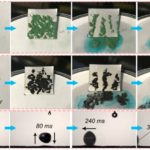Paper, Lotus-Inspired Multiscale Superhydrophobic AA5083 Resisting Surface Contamination and Marine Corrosion Attack
The massive and long-term service of 5083 aluminum alloy (AA5083) is restricted by several shortcomings in marine and industrial environments, such as proneness to localized corrosion attack, surface contamination, etc. Herein, we report a facile and cost-effective strategy to transform intrinsic hydrophilicity into water-repellent superhydrophobicity, combining fluorine-free chemisorption of a hydrophobic agent with etching texture. Dual-scale hierarchical structure, surface height relief, and surface chemical elements were studied by field emission scanning electron microscopy (FE-SEM), atomic force microscopy (AFM), energy-dispersive X-ray spectroscopy (EDS) and X-ray photoelectron spectroscopy (XPS), successively. Detailed investigations of the wetting property, self-cleaning effect, NaCl-particle self-propelling, corrosion and long-term behavior of the consequent superhydrophobic AA5083 surface were carried out, demonstrating extremely low adhesivity and outstanding water-repellent, self-cleaning and corrosion-resisting performance with long-term stability. We believe that the low cost, scalable and fluorine-free transforming of metallic surface wettability into waterproof superhydrophobicity is a possible strategy towards anti-contamination and marine anti-corrosion.
Learn about our two Decals!
 Click here to find out more about our Fall Bioinspired Design Decal and our Spring Bioinspired Design in Action Decal – ALL MAJORS are welcome.
Click here to find out more about our Fall Bioinspired Design Decal and our Spring Bioinspired Design in Action Decal – ALL MAJORS are welcome.Berkeley BioDesign Community
 Click here to learn about the BioD: Bio-Inspired Design @ Berkeley student organization or here to signup for more info.
Click here to learn about the BioD: Bio-Inspired Design @ Berkeley student organization or here to signup for more info.Search
Student Login





I imagine that the neurological circuits underlying these processes are governed by both 2d spacing maps with their brains as…
to reduce the impact of car accidents, it may be possible to study the force diverting physics of cockroaches to…
you see this type of head-bobbing stability in many avian creatures related to pigeons like chickens. the head ability to…
not like they taught horses how to run! this is an example of convergent evolution where both sea creatures and…
The brain functions in a similar way with neuronal connections. our brains are able to utilize the multiplicity of connections…